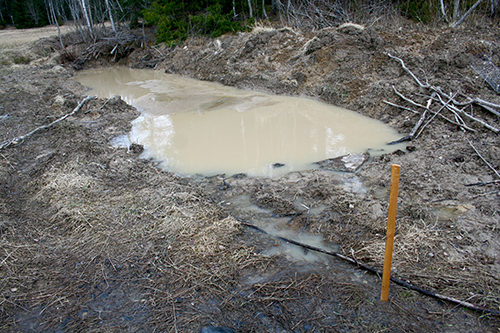The last post was about what are swales for anything and what role they could play in a woodland garden design. In this post I thought, describe how to proceed when you want to dimension and construct a swale.
Dimensionering
The dimensioning of the swales are primarily dependent on the slope of the landscape, soil infiltration capacity and rainfall patterns and amounts during the year. A swale should never overflow uncontrollably, especially on steep slopes, such an event have serious consequences in the form of landslides. Meanwhile, a swale not be oversized (ie. Insufficient distance between the ditches or deep / wide trenches or a combination thereof), because then they can not fulfill its function.
Soil infiltration capacity is a dynamic quantity that changes with time during a rain occasion and can therefore be difficult to estimate. It is for example. dependent on the grain size distribution in the soil, jordytans nature (t.ex. hard surfaces or surfaces covered with vegetation) and the amount of water already present in the soil. Sandy soils, for example, a greater infiltration capacity than clay soils. When rainfall exceeds the infiltration capacity of the earth surface runoff occurs and it is this surface runoff as it tries to catch up in a swale. Precipitation and patterns are another important factor to include in the design. If rainfall often comes in very large quantities at one time required the larger swales than if it rains regularly, smaller amounts. One way to guard against very large rain event is to connect Swalen to a pond that can take care of an overflow.

Because the maximum runoff in our latitudes is usually held in conjunction with the thaw, we can take it as a basis for design. A relatively hard packed snow cover on 3 dm in late winter can contain 100 mm water [2]. Is the ground frozen, all this can be surface runoff. A swale must therefore be able to take care of 100 mm ytavrinning, corresponding 100 liters of water per square meter. A rule of thumb for swales in our latitudes is that the distance between them can be 5 to 10 meter, depending on how big Swalen are supposed to be and what vegetation to be found on the ridge. In 10 meter long swale must therefore be able to absorb runoff from 50 to 100 square, ie. 5 to 10 cubic meters of water. The sectional area must then be between 0,5 and 1 square. In 1 meter wide swale therefore need to be 0,5 m deep on average, to take up the runoff from 50 square meter of all the snow melts at once without any water inflitrerar in the ground.
Plant
Swales constructed by first measuring a contour line in the landscape, ie. the line where all points are at the same height above sea level. This can be accomplished with a large bubble (or a spirit that is mounted on a straight plank), in A-frame or more advanced with a plane laser. The markers for each point can be 3-5 m apart on slightly sloping terrain and 2 m into steeper positions [1]. It is important to swalens top edge is reasonably in balance. More importantly, however, is that the bottom is perfectly level to ensure that water really is retained in the landscape and will not run off in any direction. Therefore, the bottom edge gradient controlled periodically during excavation. Excavation may be carried out by hand or excavator. When hand digging, our experience from Putt Myra Forest Gardening revealed that 10 people can dig 40 m swale four hours. We also have built so-called micro-swales to bushes and small trees with only 2 to 4 meters distance between Swalen, and these can be dug in significantly less time.

In areas with clayey soil, it is advisable to wait a winter before the planting of the plants on the ridge to allow the frost break up the earth of the ridge. Otherwise, do not hesitate to dig in early spring and planted at once. It takes about three years after planting on the ridge before Swalen fulfills its function altogether, because plant roots need so long time to rummage through the swale-dike [3]. Before that, it is important to water the plants regularly, then they can get hard from her well-drained habitat to reach the water they need.
References
[1] Hemenway, T., Gaia's Garden: a guide to home-scale permaculture. White River Junction, Vt.: Chelsea Green Pub., 2009.
[2] Grip, H.R.A., The path of water from rainfall to stream. Uppsala: Hallgren & Fallgren, 2000.
[3] Mollison, B.C., Permaculture : a designer’s manual. Tyalgum, Australia: Tagari Publications, 1988.


